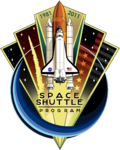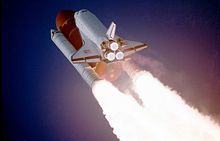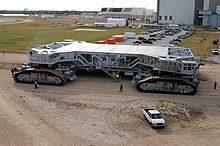- Space Shuttle program
-
This article is about the United States Space Shuttle program. For the shuttle itself, see Space Shuttle. For information on the Soviet space shuttle program, see the article Buran program.
NASA's Space Shuttle program, officially called Space Transportation System (STS), was the United States government's manned launch vehicle program from 1981 to 2011. The winged Space Shuttle orbiter was launched vertically, usually carrying four to seven astronauts (although eight have been carried) and up to 50,000 lb (22,700 kg) of payload into low Earth orbit (LEO). When its mission was complete, the shuttle could independently move itself out of orbit using its Maneuvering System (it oriented itself appropriately and fired its main OMS engines, thus slowing it down) and re-enter the Earth's atmosphere. During descent and landing the orbiter acted as a re-entry vehicle and a glider, using its OMS system and flight surfaces to make adjustments.
The shuttle is the only winged manned spacecraft to have achieved orbit and land, and the only reusable space vehicle that has ever made multiple flights into orbit. Its missions involved carrying large payloads to various orbits (including segments to be added to the International Space Station), provided crew rotation for the International Space Station, and performing service missions. The orbiter also recovered satellites and other payloads (e.g. from the ISS) from orbit and returned them to Earth, though its use in this capacity was rare. Each vehicle was designed with a projected lifespan of 100 launches, or 10 years' operational life.
The program started in the late 1960s and dominated NASA's manned operations since the mid-1970s. According to the Vision for Space Exploration, use of the space shuttle was to be focused on completing assembly of the ISS by 2011, after which it was retired. NASA planned to replace the shuttle with the Orion spacecraft, but budget cuts have placed full development of the Orion craft in doubt.[1] The program commenced on April 12, 1981, with Columbia and STS-1, the first shuttle orbital flight. The space shuttle program finished with its last mission, STS-135 flown by Atlantis, in July 2011, retiring the final shuttle in the fleet. The Space Shuttle program formally ended on August 31, 2011.[2]
Contents
Conception and development
Before the Apollo XI moon landing in 1969, NASA began early studies of space shuttle designs. In 1969 President Richard Nixon formed the Space Task Group, chaired by Vice President Spiro T. Agnew. This group evaluated the shuttle studies to date, and recommended a national space strategy including building a space shuttle.[3] The goal, as presented by NASA to Congress, was to provide a much less-expensive means of access to space that would be used by NASA, the Department of Defense, and other commercial and scientific users.[4]
During early shuttle development there was great debate about the optimal shuttle design that best balanced capability, development cost and operating cost. Ultimately the current design was chosen, using a reusable winged orbiter, reusable solid rocket boosters, and an expendable external tank.[3]
The shuttle program was formally launched on January 5, 1972, when President Nixon announced that NASA would proceed with the development of a reusable space shuttle system.[3] The intent was to launch as many as 50 missions per year, with hopes of driving down per-mission costs.[5]
The final design was less costly to build and less technically ambitious than earlier fully reusable designs. The initial design parameters included a larger external fuel tank, which would have been carried to orbit, where it could be used as a section of a space station, but this idea was killed due to budgetary and political considerations.
The prime contractor for the program was North American Aviation (later Rockwell International, now Boeing), the same company responsible for building the Apollo Command/Service Module. The contractor for the Space Shuttle Solid Rocket Boosters was Morton Thiokol (now part of Alliant Techsystems), for the external tank, Martin Marietta (now Lockheed Martin), and for the Space shuttle main engines, Rocketdyne (now Pratt & Whitney Rocketdyne, part of United Technologies).[3]
The first orbiter was originally planned to be named Constitution, but a massive write-in campaign from fans of the Star Trek television series convinced the White House to change the name to Enterprise.[6] Amid great fanfare, the Enterprise (designated OV-101) was rolled out on September 17, 1976, and later conducted a successful series of glide-approach and landing tests that were the first real validation of the design.
Program history
The first fully functional orbiter was Columbia (designated OV-102), built in Palmdale, California. It was delivered to Kennedy Space Center (KSC) on March 25, 1979, and was first launched on April 12, 1981—the 20th anniversary of Yuri Gagarin's space flight—with a crew of two. Challenger (OV-099) was delivered to KSC in July 1982, Discovery (OV-103) in November 1983, and Atlantis (OV-104) in April 1985. Challenger was originally built and used as a Structural Test Article (STA-099) but was converted to a complete shuttle when this was found to be less expensive than converting Enterprise from its Approach and Landing Test configuration, according to NASA. Challenger was destroyed during ascent due to O-Ring failure on the right solid rocket booster (SRB) on January 28, 1986, with the loss of all seven astronauts on board. Endeavour (OV-105) was built to replace Challenger (using structural spare parts originally intended for the other orbiters) and delivered in May 1991; it was first launched a year later. Seventeen years after the Challenger accident, Columbia broke up on reentry, killing all seven crew members, on February 1, 2003, and it was not replaced. NASA maintains warehoused extensive catalogs of recovered pieces from the two destroyed orbiters. Out of the five fully functional shuttle orbiters built, three remain. Enterprise, which was used for atmospheric test flights but not intended for orbital flight, had many parts taken out for use on the other orbiters. It was later visually restored and is on display at the National Air and Space Museum's Steven F. Udvar-Hazy Center.
Accidents
In 135 missions, two shuttles have been destroyed, both with the loss of crew, a total of 14 astronauts:
- Challenger – lost 73 seconds after liftoff, STS-51-L, January 28, 1986
- Columbia – lost approximately 16 minutes before its expected landing, STS-107, February 1, 2003
Status
Astronaut crews have performed vital servicing tasks on Hubble through four servicing missions since December 1993 in order to extend operating life with the replacement of aging hardware and enhancing scientific capability through the installation of advanced science instruments.
 A drag chute is deployed by Endeavour as it completes a mission of almost 17 days in space on Runway 22 at Edwards Air Force Base in southern California. Landing occurred at 1:46 pm (EST), March 18, 1995.
A drag chute is deployed by Endeavour as it completes a mission of almost 17 days in space on Runway 22 at Edwards Air Force Base in southern California. Landing occurred at 1:46 pm (EST), March 18, 1995.
From September 2005 until early 2008, the manager of the space shuttle program was Wayne Hale. Hale then became NASA's deputy associate administrator for strategic partnerships. John Shannon, who had been Hale's deputy since November 2005, succeeded him as the Space Shuttle Program Manager.[7]
After the Space Shuttle Columbia disaster in 2003, the International Space Station operated on a skeleton crew of two for more than two years and was serviced primarily by Russian spacecraft. While the "Return to Flight" mission STS-114 in 2005 was successful, a similar piece of foam from a different portion of the tank was shed. Although the debris did not strike the orbiter, the program was grounded once again for this reason.
The second "Return to Flight" mission, STS-121 launched on July 4, 2006, at 2:37 pm (EDT). Two previous launches were scrubbed because of lingering thunderstorms and high winds around the launch pad, and the launch took place despite objections from its chief engineer and safety head. A five-inch (13 cm) crack in the foam insulation of the external tank gave cause for concern; however, the Mission Management Team gave the go for launch.[8] This mission increased the ISS crew to three. Discovery touched down successfully on July 17, 2006 at 9:14 am (EDT) on Runway 15 at Kennedy Space Center.
Following the success of STS-121, all subsequent missions have been completed without major foam problems, and the construction of ISS nears completion (during the STS-118 mission in August 2007, the orbiter was again struck by a foam fragment on liftoff, but this damage was minimal compared to the damage sustained by Columbia).
The Columbia Accident Investigation Board, in its report, noted the reduced risk to the crew when a shuttle flies to the International Space Station (ISS), as the station can be used as a safe haven for the crew awaiting rescue in the event that damage to the shuttle orbiter on ascent makes it unsafe for re-entry. The board recommended that for the remaining flights, the shuttle always orbit with the station. Prior to Return to Flight, NASA Administrator Sean O'Keefe declared that all future flights of the shuttle would go to the ISS, precluding the possibility of executing the final Hubble Space Telescope servicing mission which had been scheduled before the Columbia accident, despite the fact that millions of dollars worth of upgrade equipment for Hubble were ready and waiting in NASA warehouses. Many dissenters, including astronauts, asked NASA management to reconsider allowing the mission, but initially the director stood firm. On October 31, 2006, NASA announced approval of the launch of the space shuttle, Atlantis, the fifth and final shuttle servicing mission to the Hubble Space Telescope, scheduled for August 28, 2008. However SM4/STS-125 eventually launched in May 2009.
Retirement
Main article: Space Shuttle retirementThe shuttle program, which was scheduled for mandatory retirement in 2011, saw the final launch with Atlantis launching on July 8, 2011, in accord with the directives President George W. Bush issued on January 14, 2004 in his Vision for Space Exploration.[9] The shuttle's planned successor was to be Project Constellation with its Ares I and Ares V launch vehicles and the Orion Spacecraft; however, in early 2010 the Obama administration asked Congress to instead endorse a scaled-back plan with heavy reliance on the private sector.
NASA originally planned to make the Hubble a Smithsonian museum display, but decided to keep it in space until a successor is launched.[10][11] Once the space shuttle fleet is retired this year (while Hubble still has many years of service life ahead) there will be no existing or planned spacecraft capable of returning the Hubble to Earth intact, so it is now very unlikely it will ever be on the ground again.
In an internal e-mail apparently sent August 18, 2008 to NASA managers and leaked to the press, NASA Administrator Michael Griffin stated his belief that the Bush administration had made no viable plan for U.S. crews to participate in the International Space Station beyond 2011, and that Office of Management and Budget (OMB) and Office of Science and Technology Policy (OSTP) were actually seeking its demise.[12][13] The email appeared to suggest that Griffin believed the only reasonable solution was to extend the operation of the shuttle beyond 2010, but noted that Executive Policy (i.e., the White House) is firm that there will be no extension of the shuttle retirement date, and thus no U.S. capability to launch crews into orbit until the Ares I/Orion system becomes operational in 2014 at the very earliest. He appeared to indicate that he did not see purchase of Russian launches for NASA crews as politically viable following the 2008 South Ossetia war, and hoped the new US administration will resolve the issue in 2009 by extending shuttle operations beyond 2010.[12] However, according to an article by former Space Shuttle program Director Wayne Hale on his official NASA blog, the space shuttle program, in preparation for the 2010 shutdown, has already terminated many specialty parts and materials contracts, many with small businesses whose only customer may have been the shuttle program and who closed shop and retired upon receiving their termination letters; as a result, it would be difficult and expensive at this point to extend the shuttle program, and there would be a lag of at least a year (without flights) before exhausted exotic parts and supplies could be replaced. The loss of talent from dismissed employees is another obstacle to program extension.[14]
On September 7, 2008, NASA released a statement regarding the leaked e-mail, in which Griffin said:
"The leaked internal E-mail fails to provide the contextual framework for my remarks, and my support for the administration's policies. Administration policy is to retire the space shuttle in 2010 and purchase crew transport from Russia until Ares and Orion are available. The administration continues to support our request for an INKSNA exemption. Administration policy continues to be that we will take no action to preclude continued operation of the International Space Station past 2016. I strongly support these administration policies, as do OSTP and OMB."A $2.5 billion spending provision allowing NASA to fly the space shuttle beyond its then-scheduled retirement in 2010 passed the Congress in April 2009, although neither NASA nor the White House requested the one-year extension.[16]
NASA Authorization Act of 2008
U.S. Representative Dave Weldon introduced H.R. 4837, known as the SPACE Act.[17] This legislation would have kept the shuttle flying past 2010 at a reduced rate until the Orion spacecraft would have been ready to replace it. It would also have allowed the Alpha Magnetic Spectrometer to be launched to the ISS, which the schedule at the time did not allow.[18]
On October 15, 2008, President Bush signed the NASA Authorization Act of 2008, giving NASA funding for one additional mission to "deliver science experiments to the station."[19][20][21][22] The act allowed for an additional space shuttle flight, STS-134, to the ISS to install the Alpha Magnetic Spectrometer, which was previously canceled.[23]
Successor
On September 14, 2011, NASA announced that it had selected the design of a new Space Launch System that it said would take the agency's astronauts farther into space than ever before and provide the cornerstone for future human space exploration efforts by the U.S.[24][25][26]
Shuttle applications
Space shuttle applications have included:
- Spacelab missions[27] Including:
- Crew rotation and servicing of Mir and the International Space Station (ISS)
- Manned servicing missions, such as to the Hubble Space Telescope (HST)
- Manned experiments in low Earth orbit (LEO)
- Carried to LEO:
- Components for the construction of the ISS
- Supplies in Spacehab modules or Multi-Purpose Logistics Modules
- Carried satellites with a booster, the Payload Assist Module (PAM-D) or the Inertial Upper Stage (IUS), to the point where the booster sends the satellite to:
- A higher Earth orbit; these have included:
- Chandra X-ray Observatory
- Many TDRS satellites
- Two DSCS-III (Defense Satellite Communications System) communications satellites in one mission
- A Defense Support Program satellite
- An interplanetary mission; these have included:
- Magellan probe
- Galileo spacecraft
- Ulysses probe
- A higher Earth orbit; these have included:
Budget
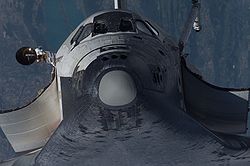 Space Shuttle Discovery as it approaches the International Space Station during STS-114 on July 28, 2005
Space Shuttle Discovery as it approaches the International Space Station during STS-114 on July 28, 2005
Early during development of the space shuttle, NASA had estimated that the program would cost $7.45 billion ($43 billion in 2011 dollars, adjusting for inflation) in development/non-recurring costs, and $9.3M ($54M in 2011 dollars) per flight.[28] Early estimates for the cost to deliver payload to low earth orbit were as low as $118 per pound ($260/kg) of payload ($635/pound in 2011 dollars), based on marginal or incremental launch costs, and assuming a 65,000 pound (30 000 kg) payload capacity and 50 launches per year.[29][30]
The actual total cost of the shuttle program through 2011, adjusted for inflation, is $196 billion.[5] The exact breakdown into non-recurring and recurring costs is not available, but, according to NASA, the average cost to launch a Space Shuttle as of 2011 is about $450 million per mission.[31]
NASA's budget for 2005 allocated 30%, or $5 billion, to space shuttle operations;[32] this was decreased in 2006 to a request of $4.3 billion.[33] Non-launch costs account for a significant part of the program budget: for example, during fiscal years 2004 to 2006, NASA spent around $13 billion on the space shuttle program,[34] even though the fleet was grounded in the aftermath of the Columbia disaster and there were a total of three launches during this period of time. In fiscal year 2009, NASA budget allocated $2.98 billion for 5 launches to the program, including $490 million for "program integration", $1.03 billion for "flight and ground operations", and $1.46 billion for "flight hardware" (which includes maintenance of orbiters, engines, and the external tank between flights.)
Per-launch costs can be measured by dividing the total cost over the life of the program (including buildings, facilities, training, salaries, etc.) by the number of launches. With 134 missions, and the total cost of US$192 billion (in 2010 dollars), this gives approximately $1.5 billion per launch over the life of the program.[35]
Assets and transition plan
The Space Shuttle Program occupies over 654 facilities, uses over 1.2 million line items of equipment and employs over 5,000 people. The total value of equipment is over $12 billion. Shuttle related facilities represent over a quarter of NASA's inventory. There are over 1,200 active suppliers to the program throughout the United States. NASA's transition plan has the program operating through 2010 with a transition and retirement phase lasting through 2015. During this time the Ares I and Orion as well as the Altair Lunar Lander were to be under development[36] (although now these programs have been canceled).
Criticism
The space shuttle program has been criticized for failing to achieve its promised cost and utility goals, as well as design, cost, management, and safety issues.[37]
After both the Challenger disaster and the Columbia disaster, high profile boards convened to investigate the accidents with both committees returning praise and serious critiques to the program and NASA management. Some of the most famous of the criticisms, most of management, came from Nobel Prize winner Richard Feynman, in his report that followed his appointment to the commission responsible for investigating the Challenger disaster.[38]
Other STS program vehicles
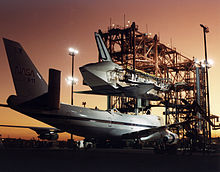 STS Program mate/de-mate facility for STS Orbiter and STS Shuttle Carrier Aircraft (Space Shuttle Atlantis in 1991)
STS Program mate/de-mate facility for STS Orbiter and STS Shuttle Carrier Aircraft (Space Shuttle Atlantis in 1991)
Many other vehicles were used in support of the Space Shuttle program, mainly terrestrial transportation vehicles.
- The Crawler-Transporter carried the Mobile Launcher Platform and the space shuttle from the Vehicle Assembly Building at Launch Complex 39 to Pad A.
- The Shuttle Carrier Aircraft are two modified Boeing 747s. Either can fly an orbiter from alternative landing sites back to the Kennedy Space Center.
- A 36-wheeled transport trailer, the Orbiter Transfer System, originally built for the U.S. Air Force's launch facility at Vandenberg Air Force Base in California (since then converted for Delta IV rockets) would transport the orbiter from the landing facility to the launch pad, which allowed both "stacking" and launch without utilizing a separate VAB-style building and crawler-transporter roadway. Prior to the closing of the Vandenberg facility, orbiters were transported from the OPF to the VAB on their undercarriages, only to be raised when the orbiter was being lifted for attachment to the SRB/ET stack. The trailer allowed the transportation of the orbiter from the OPF to either the SCA-747 "Mate-Demate" stand or the VAB without placing any additional stress on the undercarriage.
- The Crew Transport Vehicle (CTV), a modified airport jet bridge, was used to assist astronauts to egress from the orbiter after landing. Upon entering the CTV, astronauts could take off their launch and re-entry suits then proceed to chairs and beds for medical checks before being transported back to the crew quarters in the Operations and Checkout Building.
- The Astrovan was used to transport astronauts from the crew quarters in the Operations and Checkout Building to the launch pad on launch day. It was also used to transport astronauts back again from the Crew Transport Vehicle at the Shuttle Landing Facility.
See also
- Human spaceflight
- List of human spaceflights
- List of space shuttle missions
- Shuttle Derived Launch Vehicle
- Shuttle SERV
- Space accidents and incidents
- Space exploration
- Space Shuttle abort modes
- Space Shuttle crews
- Fiction
- Space Flight Simulator
- Orbiter Simulation
- Space Shuttle Mission 2007
- Physics
- Similar spacecraft
- Avatar RLV
- EADS Phoenix
- Hermes
- HOPE-X
- VentureStar
- Kliper
- Military space shuttle
- Project Constellation
- Shuttle Buran program
- Martin Marietta Spacemaster
References
- ^ Chang, Kenneth (May 16, 2010) "Busy Schedule for Rocket Obama Wants Scrapped" The New York Times
- ^ http://www.spaceflightnow.com/news/n1108/29shannon/
- ^ a b c d Hepplewhite, T.A. The Space Shuttle Decision: NASA's Search for a Reusable Space Vehicle. Washington, DC: National Aeronautics and Space Administration, 1999.
- ^ General Accounting Office. Cost Benefit Analysis Used in Support of the Space Shuttle Program. Washington, DC: General Accounting Office, 1972.
- ^ a b Borenstein, Seth (July 5, 2011). "AP Science Writer". Boston Globe. Associated Press. http://www.boston.com/news/science/articles/2011/07/05/space_shuttles_legacy_soaring_in_orbit_and_costs/. Retrieved July 5, 2011.
- ^ Brooks, Dawn The Names of the Space Shuttle Orbiters. Washington, DC: National Aeronautics and Space Administration. Retrieved July 26, 2006.
- ^ "NASA Selects New Deputy Associate Administrator of Strategic Partnerships and Space Shuttle Program Manager". NASA. http://www.nasa.gov/home/hqnews/2008/feb/HQ_08065_New_Shuttle_Manage.html.
- ^ Chien, Philip (June 27, 2006) "NASA wants shuttle to fly despite safety misgivings." The Washington Times
- ^ President George W. Bush (Attributed) (2004). "President Bush Offers New Vision For NASA". nasa.gov. http://www.nasa.gov/missions/solarsystem/bush_vision.html. Retrieved January 14, 2004.
- ^ "NASA -Consolidated Launch Manifest". Nasa.gov. July 13, 2009. http://www.nasa.gov/mission_pages/station/structure/iss_manifest.html. Retrieved July 17, 2009.
- ^ National Aeronautics and Space Administration. "NASA Names New Rockets, Saluting the Future, Honoring the Past" Press Release 06-270. June 30, 2006.
- ^ a b Michael Griffin (Attributed) (2008). "Internal NASA email from NASA Administrator Griffin". SpaceRef.com. http://www.spaceref.com/news/viewsr.html?pid=29133. Retrieved November 25, 2008.
- ^ Malik, Tariq (2008). "NASA Chief Vents Frustration in Leaked E-mail". Space.com. http://www.space.com/news/080907-nasa-griffin-email.html. Retrieved November 6, 2008.
- ^ Wayne Hale (August 28, 2008). "Shutting down the shuttle". Wiki.nasa.gov. http://wiki.nasa.gov/cm/blog/waynehalesblog/posts/post_1219932905350.html. Retrieved July 17, 2009.
- ^ "Statement of NASA Administrator Michael Griffin on Aug. 18 Email" (Press release). NASA. September 7, 2008. http://www.nasa.gov/home/hqnews/2008/sep/HQ_08220_griffin_statement_email.html. Retrieved November 6, 2008.
- ^ Mark, Roy "Mandatory Shuttle Retirement Temporarily Postponed" (April 30, 2009) Green IT, e-week.com
- ^ "HR 4837 Spacefaring Priorities for America's Continued Exploration Act". http://www.spaceref.com/news/viewsr.html?pid=26439. Retrieved March 28, 2008.
- ^ "H.R. 4837: Space Act (GovTrack.us)". http://www.govtrack.us/congress/bill.xpd?bill=h110-4837. Retrieved March 28, 2008.
- ^ "To authorize the programs of the National Aeronautics and Space Administration.". Library of Congress. 2008. http://thomas.loc.gov/cgi-bin/bdquery/z?d110:h.r.06063:. Retrieved October 25, 2008.
- ^ Berger, Brian (June 19, 2008). "House Approves Bill for Extra Space Shuttle Flight". Space.com. http://www.space.com/news/080619-house-shuttle-flight-bill.html. Retrieved October 25, 2008.
- ^ NASA (September 27, 2008). "House Sends NASA Bill to President's Desk". Spaceref.com. http://www.spaceref.com/news/viewpr.html?pid=26558. Retrieved November 23, 2008.
- ^ Matthews, Mark (October 15, 2008). "Bush signs NASA authorization act". Orlando Sentinel. http://blogs.orlandosentinel.com/news_space_thewritestuff/2008/10/bush-signs-nasa.html. Retrieved October 25, 2008.
- ^ Berger, Brian for Space.com (September 23, 2008). "Obama backs NASA waiver, possible shuttle extension". USA Today. http://www.usatoday.com/tech/science/space/2008-09-23-obama-nasa-shuttle_N.htm. Retrieved November 6, 2008.
- ^ Release:11-301, NASA (September 14, 2011). "NASA Announces Design For New Deep Space Exploration System". NASA. http://www.nasa.gov/home/hqnews/2011/sep/HQ_11-301_SLS_Decision.html. Retrieved September 14, 2011.
- ^ VideoLibrary, C-Span (September 14, 2011). "Press Conference on the Future of NASA Space Program". c-span.org. http://www.c-span.org/Events/Press-Conference-on-the-Future-of-NASA-Space-Program/10737424158/. Retrieved September 14, 2011.
- ^ NewYorkTimes, The (September 14, 2011). "NASA Unveils New Rocket Design". nytimes.com. http://www.nytimes.com/2011/09/15/science/space/15nasa.html?pagewanted=1&_r=1. Retrieved September 14, 2011.
- ^ a b c d e "Spacelab joined diverse scientists and disciplines on 28 Shuttle missions". NASA. March 15, 1999. http://science.nasa.gov/science-news/science-at-nasa/1999/msad15mar99_1/. Retrieved February 11, 2011.
- ^ Bulletin of the Atomic Scientists. February 1973. p. 39.
- ^ NASA (2003) Columbia Accident Investigation Board Public Hearing Transcript
- ^ Comptroller General (1972). "Report to the Congress: Cost-Benefit Analylsis Used in Support of the Space Shuttle Program" (pdf). United States General Accounting Office. http://archive.gao.gov/f0302/096542.pdf. Retrieved November 25, 2008.
- ^ NASA (2011). "How much does it cost to launch a Space Shuttle?". NASA. http://www.nasa.gov/centers/kennedy/about/information/shuttle_faq.html#10. Retrieved June 28, 2011.
- ^ David, Leonard (February 11, 2005). "Total Tally of Shuttle Fleet Costs Exceed Initial Estimates". Space.com. http://www.space.com/news/shuttle_cost_050211.html. Retrieved August 6, 2006.
- ^ Berger, Brian (February 7, 2006). "NASA 2006 Budget Presented: Hubble, Nuclear Initiative Suffer". Space.com. http://www.space.com/news/nasa_budget_050207.html. Retrieved August 6, 2006.
- ^ "NASA Budget Information". http://www.nasa.gov/news/budget/index.html.
- ^ Pielke Jr., Roger; Radford Byerly (7 April 2011). Shuttle programme lifetime cost. 472. Nature. doi:10.1038/472038d. http://www.nature.com/nature/journal/v472/n7341/full/472038d.html. Retrieved July 14, 2011.
- ^ Olson, John; Joel Kearns (August 2008). "NASA Transition Management Plan". JICB-001. National Aeronautics and Space Administration. http://www.nasa.gov/pdf/202388main_Transition_Mgmt_Plan-Final.pdf.
- ^ A Rocket to Nowhere, Maciej Cegłowski, Idle Words, March 8, 2005.
- ^ [1], additional text.
Further reading
- Shuttle Reference manual
- Orbiter Vehicles
- Shuttle Program Funding 1992 – 2002
- NASA Space Shuttle News Reference – 1981 (PDF document)
- R. A. Pielke, "Space Shuttle Value open to Interpretation", Aviation Week, issue 26. July 1993, p. 57 (.pdf)
External links
- Official NASA Mission Site
- NASA Johnson Space Center Space Shuttle Site
- Official Space Shuttle Mission Archives
- NASA Space Shuttle Multimedia Gallery & Archives
- Shuttle audio, video, and images – searchable archives from STS-67 (1995) to present
- Kennedy Space Center Media Gallery – searchable video/audio/photo gallery
- Congressional Research Service (CRS) Reports regarding the Space Shuttle
- U.S. Space Flight History: Space Shuttle Program
- Weather criteria for Shuttle launch
- Consolidated Launch Manifest: Space Shuttle Flights and ISS Assembly Sequence
- USENET posting – Unofficial Space FAQ by Jon Leech
- Witnesses' Waltz by Leslie Fish – 1986 Pegasus Award Winner for Best Original Song, about watching the Space Shuttles launch
NASA Space Shuttle (STS) Core topics 


Components Orbiters Add-ons Sites Operations Missions (cancelled) · Crews · Mission timeline · rollbacks · Abort modes · Rendezvous pitch maneuverTesting Disasters Support Special Derivatives Related Space Shuttle design process · Inertial Upper Stage · Payload Assist Module · ISS · Space Shuttle retirement · Explorer (shuttle replica)Space Shuttles  United States Space Shuttle program
United States Space Shuttle program Soviet Buran program
Soviet Buran program- Pathfinder (OV-098, ground tests)
- Enterprise (OV-101, atmospheric tests, retired)
- Columbia (OV-102, destroyed 2003)
- Challenger (OV-099, destroyed 1986)
- Discovery (OV-103, retired)
- Atlantis (OV-104, retired)
- Endeavour (OV-105, retired)
United States human spaceflight programs Active ISS (joint)

Previous X-15 (suborbital) · Mercury · Gemini · Apollo · Skylab · Apollo-Soyuz (with USSR) · Space Shuttle · Shuttle-Mir (with Russia)
Canceled Categories:- Human spaceflight
- NASA programs
- Space Shuttle program
- 1981 establishments
- 2011 disestablishments
Wikimedia Foundation. 2010.


